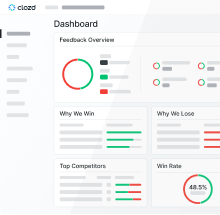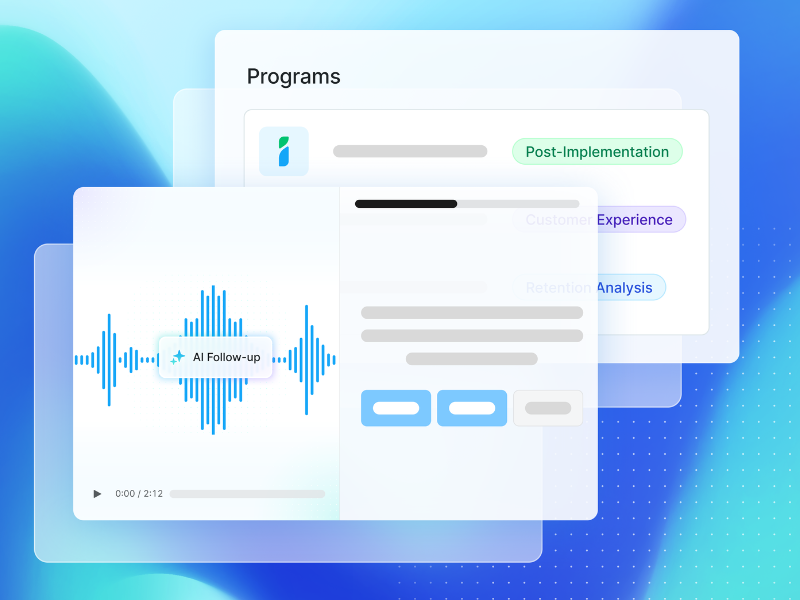In today's rapidly evolving business environment, recognizing the significance of customer experience (CX) and utilizing retention analysis insights are fundamental for B2B organizations intent on deepening customer relationships, enhancing satisfaction, and reducing churn. As more companies embrace digital transformation and face heightened competition, prioritizing the customer journey becomes a strategic necessity. This article delves into practical ways organizations can leverage insights from customer experience interviews and retention analysis to craft retention strategies that provide measurable business value. Covered throughout are actionable suggestions and a focus on real-world application for B2B firms determined to stand out in their industries.
Customer Experience (CX) and Its Role in Retention
Customer Experience (CX) represents every interaction and impression a client has with your company—from first touch through ongoing engagement. It’s not limited to customer service; CX spans sales, onboarding, communications, and product use. Strong CX creates smooth, personalized, and emotionally resonant experiences that connect customers to your brand’s values and build long-term trust.
Regularly revisiting CX processes helps organizations stay aligned with evolving customer expectations. For B2B companies, in particular, CX thrives as a cross-functional effort—uniting feedback from sales, product, and support teams to deliver consistent, high-quality experiences at every stage of the journey.
CX is also one of the most powerful drivers of retention. Positive experiences inspire loyalty, encourage repeat business, and fuel advocacy, while poor interactions often lead directly to churn. Companies that invest in CX report higher satisfaction, deeper engagement, and greater lifetime value—making it a cornerstone for sustainable growth and customer success.
Retention Analysis: Uncovering Insights to Reduce Churn
Retention analysis is a systematic approach to investigating the reasons customers leave or renew. By scrutinizing data trends and behavioral patterns, companies can identify pain points and strengths throughout the customer journey, gaining a clearer understanding of what influences ongoing loyalty or motivates exits.
How Retention Analysis Works
An effective retention analysis program typically follows these steps:
- Data Collection: Consolidate information from multiple sources, including customer feedback, purchasing and usage behavior, support interactions, and product performance. Modern analytics tools enable organizations to collect more granular data than ever before.
- Segmentation: Group customers based on attributes such as industry, company size, product usage, or lifecycle stage. Proper segmentation uncovers hidden patterns in how different cohorts respond to engagement strategies and where potential risks may exist.
- Analysis: Dive into each segment to uncover correlations between actions (like onboarding quality, support resolution speed, or product adoption rates) and retention. Advanced analytics, such as predictive modeling, can flag accounts at risk of churn for proactive outreach.
- Strategy Development: Turn findings into concrete action items. For example, if data reveals that customers who engage with onboarding resources have higher retention, strengthening onboarding programs should become a strategic focus.
- Implementation: Roll out targeted retention strategies such as loyalty initiatives, customer education efforts, or refined customer success workflows. Continuously monitor the impact of these changes to refine approaches over time.
Key Metrics in Retention Analysis
Certain metrics provide a window into the health of customer relationships and the effectiveness of retention initiatives:
- Retention Rate: The proportion of customers staying during a defined period—a critical measure of loyalty and satisfaction.
- Churn Rate: The percentage of customers stopping business due to dissatisfaction, unmet needs, or competitive offerings. This is a direct signal of areas requiring attention.
- Customer Lifetime Value (CLV): Estimates the total expected revenue from a customer over their journey. Knowing CLV helps organizations prioritize retention efforts towards high-value accounts.
Additional metrics—such as Net Promoter Score (NPS), engagement rates, and support ticket volumes—can provide deeper context around the emotions and behaviors driving customer decisions.
Leveraging Customer Experience Interviews
Customer experience interviews are invaluable for gaining unfiltered, in-depth feedback on a brand’s strengths and areas for growth. While surveys and analytics reveal trends, interviews illuminate the context, motivations, and emotional drivers behind those trends. Thoughtful CX interviews create space for clients to share stories, address concerns, and feel truly heard by their partners.
Conducting Effective CX Interviews
For maximum value, companies should follow structured processes when conducting interviews:
- Prepare Thoughtful Questions: Move beyond basic inquiries and focus on open-ended questions designed to probe deeper experiences, pain points, and suggestions for improvement. Asking “What could have improved your onboarding?” or “Can you recall a time you felt especially supported by our team?” yields richer, actionable insights.
- Listen Actively: Genuine listening—attending not just to words but also to emotions and emphasis—builds rapport and may uncover latent needs or frustrations.
- Analyze Feedback: After interviews, regularly review responses for recurring themes, unique challenges, and positive standout moments. This analysis informs where to double down efforts or act quickly to resolve pain points.
- Act on Insights: Feedback only provides value when it’s transformed into action. Closing the loop by implementing relevant changes and informing customers of improvements demonstrates a true commitment to their success.
Scaling these interviews through recurring programs ensures ongoing visibility into evolving needs, especially as products or services expand.
Use Cases and Practical Applications of Insights
Companies can harness data-driven insights in a range of scenarios to drive growth, streamline processes, and inform decision-making. Across industries, leveraging customer insights empowers organizations to enhance their responsiveness, efficiency, and long-term competitiveness.
For example, consider a retail business looking to optimize its inventory management. By analyzing purchasing trends and customer behavior, the company can identify which products are most in demand during specific seasons. Armed with this information, management can adjust inventory orders, minimize stockouts, and reduce excess inventory—leading to both cost savings and increased customer satisfaction. Additionally, understanding shifting preferences allows retailers to introduce new products at the right time, meet customer expectations, and pivot quickly in response to market trends.
Another hypothetical scenario might involve a technology startup aiming to improve its digital marketing efforts. By leveraging insights from user engagement data, the business can pinpoint which marketing channels deliver the best return on investment and tailor campaigns accordingly. This targeted approach not only increases conversion rates but also helps allocate resources more efficiently. The startup may also discover emerging customer segments or uncover specific content that resonates most with users, enabling further campaign refinement.
In both examples, the actionable application of insights transforms raw data into strategic advantage, demonstrating how businesses can convert information into measurable outcomes.
Some key business outcomes that can result from acting on customer insights include:
- Improved customer retention and loyalty
- Enhanced product or service offerings tailored to evolving needs
- Increased sales through personalized marketing and cross-selling
- More accurate demand forecasting and inventory management
- Faster adaptation to shifting market conditions
- Reduced operational costs by identifying inefficiencies
- Better allocation of marketing and sales resources
- Higher overall customer satisfaction ratings
By integrating these insights into decision-making processes, organizations can proactively address challenges, seize new opportunities, and maintain an edge in competitive markets.
Strategies to Improve Customer Retention
Sustainable customer retention stems from thoughtful strategy and relentless execution. By understanding what drives loyalty—and proactively addressing sources of friction—companies build a culture where customers feel valued and connected.
Personalization
Tailoring touchpoints and communication to each account’s unique context drives relevance and trust. Leverage data from CX interviews to align messaging, recommend tailored solutions, and adjust engagement cadence based on individual customer journeys. Examples include custom onboarding plans for new customers or personalized content for long-term clients seeking to expand usage.
Proactive Customer Support
Anticipating client needs and resolving potential issues before they escalate cultivates confidence and loyalty. This might involve monitoring product usage data to flag potential challenges, following up after onboarding milestones, or offering educational webinars to answer common questions.
Continuous Engagement
Maintain consistent, positive contact throughout the customer lifecycle. Examples include regular check-ins with customer success teams, curated educational content, and industry insights tailored to a client’s interests. This approach deepens relationships, uncovers expansion opportunities, and reduces the risk of competitors enticing clients away.
Feedback Loops
Create systems enabling clients to share feedback regularly and easily. This might take the form of quarterly business reviews, ongoing surveys, or programmatic listening posts. A visible, reliable feedback loop positions your company as a partner invested in continuous improvement—and invites customers to co-create better solutions.
Clozd Retention Case Studies
Our case studies highlight real-world examples of how leading organizations have leveraged customer feedback and experience intelligence to strengthen retention and reduce churn. Each story demonstrates how actionable insights—gathered through customer interviews and data analysis—translate into measurable improvements in onboarding, account management, and customer engagement. These examples show how companies across industries are transforming their customer relationships and building long-term loyalty through the power of feedback.
How Reputation uses customer feedback to build stronger renewal strategies
How closing the feedback loop and elevating customer voices strengthens brand trust—reducing churn risk by addressing root-cause friction and reinforcing perceived value.
Read Reputation's case study here
Xactly: Reducing Churn with Buyer & Customer Interviews
Xactly’s CS team pairs structured interviews with thematic analysis to uncover the real drivers of attrition, enabling targeted fixes in onboarding, enablement, and product that improve renewal outcomes.
Clearbit: Product-Led Retention Through Deeper Customer Insight
Clearbit uses interview-driven insights to build buyer empathy, prioritize the roadmap, and resolve adoption blockers—boosting ongoing value realization and long-term retention.
Read Clearbit's case study here
Conclusion
Prioritizing customer experience and adopting a rigorous, data-informed approach to retention analysis empowers organizations to understand and serve their clients at a deeper level. With comprehensive analysis, meaningful customer interviews, and the implementation of targeted strategies, B2B companies can directly address the underlying causes of churn and nurture lasting customer relationships. As a trusted partner for organizations seeking actionable insights from customer feedback, Clozd supports companies in making confident decisions that foster growth, resilience, and a customer-first culture. Embracing a commitment to ongoing improvement in CX and retention is not just a differentiator—it’s a necessity for enduring success in the modern marketplace.











.svg)










.svg)

.svg)




